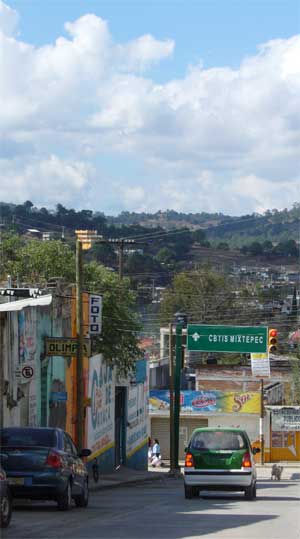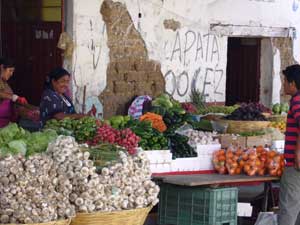Revolution #80, March 4, 2007
Report from Oaxaca
Part 4—The Changing Landscape of the Mixteca
'At the end of last year, we went on an investigative reporting trip to Oaxaca, Mexico. We were part of a human rights delegation investigating and documenting the repression in this southern Mexican state, and had the opportunity to meet and talk with many different kinds of people. The first two parts of our report were written while we were in Oaxaca. (“Part 1—The Prisoners of Tepic” in issue #75, and “Part 2—Days of Fear, Joy, and Determination” in issue #76, online at revcom.us.) Part 3--“From the City to the Mixteca Mountains,” which appeared in last week's issue, was about our encounters with one of the striking teachers and with indigenous campesinos who joined the struggle against the government.
|
The Mixteca is a large region in the state of Oaxaca, bordering the states of Puebla and Guerrero, with a majority indigenous population. The landscape here is diverse, with rocky hills, valleys, and forested mountain regions at the high elevations. Some areas are green and fertile. Other areas are dry and arid because of the natural soil composition of the land, but also because commercial fertilizers have destroyed the productivity of the land.
The people who live in the area are also diverse. They are from different indigenous groups that speak different languages, vary in their cultural traditions and mannerisms, and wear distinct traditional clothes. There have been sharp conflicts between some of the indigenous groups, like the Mixteca and the Chatinos, resulting in violent land disputes that have left many widows and orphans in some villages.
The Mixtecas are among the most impoverished people in Oaxaca. Some are able to make a partial living through selling produce from their small crops as well as textiles, baskets, and other merchandise at local market places. However, as in many areas around Mexico, a large percentage of people in the Mixteca survive from the remesas—money earned and sent back by people who have gone to the U.S. to work. Remesas are Mexico’s second greatest source of revenue, totaling almost 24 billion dollars a year--second only to the revenue generated by the petroleum industry.
On the days that the remesas come in, lines of people—mostly women—form around the block where the bank or the money transfer place is located. On weekends there are also lines of people waiting to use public telephones to call their loved ones. Remesas from immigrants are often used by the communities for public works projects—like paving roads, building wells, and building parks and playgrounds. In towns where there are few or no doctors and little or no medicine, the remesas subsidize the costs of getting medical supplies, because the government does not provide the funds necessary for the needs of the people.
Years ago, many campesinos in this region survived from growing coffee on their land. But this became impossible after the price of coffee plummeted on the world market. The only alternative was for large numbers of campesinos to leave their villages and migrate to the cities or to the U.S.
According to a human rights organization in the Mixteca, Ñu’uji Kandi, people are migrating out of this region at an unprecedented rate. It is not uncommon to find communities throughout the Mixteca—and other rural regions in Oaxaca—that are ghost towns. There are many villages that are very sparsely populated, with only women, small children, and elderly left, because many of the men and the youth—including boys and girls as young as 14 years old—have migrated to Mexico City, Tijuana, Juarez, and other large cities or across the U.S./Mexico border. For many youth, finishing middle school, much less going to the university, is not in their plans for the future—most plan to make the journey to the U.S. at the soonest possible moment.
* * * * *
U.S. imperialist domination of Mexico is not only changing the economic and social landscape—it's also changing the natural landscape of Oaxaca.
Manuel is 60 years old, his beard long and white, and he has lived his entire life in the forest. He told us that unless you’ve been there, it’s hard to imagine how beautiful the forest is. He described how the land was once full of pine trees, rabbits, pristine water, and wild orchids and other flowers. He’s been active in defending the forests for a number of years against the lumber industry and the accelerating rate of environmental destruction as a result of Plan Puebla Panama (PPP).
PPP was inaugurated in 2001 by the presidents of Mexico and the countries of Central America who claimed it would “bring progress to forgotten people.” In reality, the plan brings a nightmare of imperialist “development” to the southeastern states of Mexico and the seven Central American countries. Financed by the U.S.-controlled Inter-American Development Bank and the World Bank, along with some involvement of European capital, PPP is aimed at transforming this whole region into one big sweatshop. It means leveling ancient forests to build 8-lane highways and grow industry friendly trees. It means more dams to generate electricity for the maquiladora factories that generate huge profits for the capitalists.
“They want to build highways. They want to bring in a lot of things. We don’t want them to destroy the countryside,” said Manuel. “The forests are the lungs of humanity.”
He said that he wants to leave a legacy to his grandchildren—not just his small plot of land, but a legacy of fighting back against repression. And not just resistance against what's happening to his village or the neighboring villages, but a legacy of a larger struggle, like what has been going on in Oaxaca for the past 7 months.
* * * * *
After the news reached the Mixteca about the vicious attack on the striking teachers in Oaxaca City on June 14 last year, many campesinos were at first hesitant to support the teachers for different reasons. Some, for example, were afraid that the state government headed by Ulises Ruiz Ortiz would withhold the little money they allotted to rural communities if they learned what areas were supporting the teachers’ struggle.
But the teachers' strike—and the whole movement to demand the ouster of the hated governor--touched off a lot of back-and-forth among the people in communities throughout the Mixteca. Rolando, a human rights activist with Ñu’uji Kandi, said, “You hear about [the rebellion in Oaxaca City] at bars, you hear about it at the family dinner table, and all over the place. In many ways it has awoken another kind of consciousness among the people. There’s talk about what is required to resolve this situation—that it’s not just a matter of the governor leaving, but that along with that there have to be deep changes...for other kinds of social relations.”
If you like this article, subscribe, donate to and sustain Revolution newspaper.





